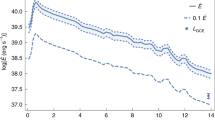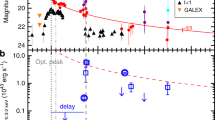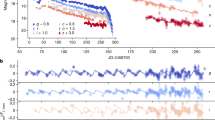Abstract
A LOW-MASS X-ray binary (LMXB) consists of a compact star, probably a neutron star, accreting mass from a low-mass (≤ M⊙) companion via an accretion disk. Of ∼100 known LMXBs in the Galaxy, only four have stable enough X-ray modulations to have allowed the reliable determination of orbital period changes. For these four LMXBs, all of which have Porb≤5.6h, the measured values1–4 of P⊙orb/Porb disagree markedly with what would be expected for orbital evolution driven by angular momentum loss due to gravitational radiation, possibly supplemented by magnetic braking; the empirically derived timescale for orbital evolution is ∼100 times less than expected. On the assumption that the observed period changes are secular, and not due to some longer-term periodic change, I argue here that the observed behaviour of LMXBs can be explained as the result of mass loss from the companion star caused by irradiation of the secondary star and accretion disk by the primary5. The typical lifetime of a radiation-driven LMXB is expected to be ∼106–107yr. This reduced evolutionary timescale can resolve the statistical discrepancy between the number of binary millisecond pulsars and of their presumed LMXB progenitors if about half of all the LMXBs are radiation-driven5–7.
This is a preview of subscription content, access via your institution
Access options
Subscribe to this journal
Receive 51 print issues and online access
$199.00 per year
only $3.90 per issue
Buy this article
- Purchase on Springer Link
- Instant access to full article PDF
Prices may be subject to local taxes which are calculated during checkout
Similar content being viewed by others
References
Kitamoto, S., Miyamoto, S. & Matsui, W. Publs. astr. Soc. Japan 39, 259–285 (1987).
Hellier, C., Mason, K. O., Smale, A. P. & Kilkenny, D. Mon. Not. r. astr. Soc. 244, 39P–43P (1990).
Parmar, A. N., Verbunt, F., Smale, A. P. & Corbet, R. H. D. Astrophys. J. 366, 253–260 (1991).
Tan, J. et al. Astrophys. J. in the press.
Tavani, M. in Proc. 23rd ESLAB Symp. on X-Ray Binaries Vol. 1 (ed. White, N.) 241–246 (ESA spec. Publ. 296, 1989).
Tavani, M. Bull. Am. astr. Soc. 24, 1204 (1989).
Tavani, M. Astrophys. J. 366, L27–L31 (1981).
Faulkner, J. Astrophys. 170, L99–L102 (1971).
Rappaport, S., Joss, P. C. & Webbink, R. F. Astrophys. 254, 616 (1982).
Verbunt, F. Mon. Not. R. Astr. Soc. 209, 227–240 (1984).
Rappaport, S., Verbunt, F. & Joss, P. C. Astrophys. J. 275, 713 (1983).
Pylyser, E. & Savonije, G. J. Astr. Astrophys. 191, 57 (1988).
Stella, L., White, N. & Priedhorsky, W. Astrophys. J. 315, L49 (1987).
Rappaport, S., Nelson, L. A., Ma, C. P. & Joss, P. C. Astrophys. J. 322, 842–851 (1987).
Ruderman, M., Shaham, J. & Tavani, M. Astrophys. J. 336, 507 (1989).
Ruderman, M., Shaham, J., Tavani, M. & Eichler, D. Astrophys. J. 343, 292 (1989).
Tavani, M., Ruderman, M. & Shaham, J. Astrophys. J. 342, L31 (1989).
London, R. A., McCray, R. & Auer, L. H. Astrophys. J. 243, 970 (1981).
Arons, J. Astrophys. J. 184, 539–547 (1973).
Basko, M. M. & Sunyaev, R. A. Astrophys. Space Sci. 23, 117–128 (1974).
London, R. A. & Flannery, B. P. Astrophys. J. 258, 260–267 (1982).
Begelman, M. C. & McKee, C. F. Astrophys. J. 271, 89 (1983).
Savonije, G. J. in Accretion-Driven X-Ray Sources (eds Lewin, W. H. G. & van den Heuvel, E. P. J.) 343 (Cambridge University Press, 1983).
Molnar, L. A. Astrophys. J. 331, L25 (1988).
Fruchter, A. S., Stinebring, D. R. & Taylor, J. H. Nature 333, 237 (1988).
Molnar, L. A., Kouba, J. A. & Raymond, J. C. Bull. Am. astr. Soc. 22, 1339 (1990).
Ritter, H. Astr. Astrophys. Suppl. (in the press).
van der Klis, M. & Bonnet-Bidaud, J. M. Astr. Astrophys. 95, L5–L9 (1981).
Willingdale, R., King, A. R. & Pounds, K. A. Mon. Not. r. astr. Soc. 215, 295 (1985).
Author information
Authors and Affiliations
Rights and permissions
About this article
Cite this article
Tavani, M. Orbital evolution of low-mass X-ray binaries due to radiation driven mass transfer. Nature 351, 39–41 (1991). https://doi.org/10.1038/351039a0
Received:
Accepted:
Issue Date:
DOI: https://doi.org/10.1038/351039a0
This article is cited by
-
The origin of planets orbiting millisecond pulsars
Nature (1992)
Comments
By submitting a comment you agree to abide by our Terms and Community Guidelines. If you find something abusive or that does not comply with our terms or guidelines please flag it as inappropriate.



